By September 1, 2005,
three days after Hurricane Katrina made landfall,
23 states had National Guard forces
in the operating area, with boots on the ground.

An Oregon National Guard patrol from C Company, 2nd Battalion, 162nd Infantry, moves up Paris Avenue in north New Orleans, to verify no people remain there in need of help or evacuation and to chart the boundaries of the receding floodwaters Sept. 15, 2005. U.S. Air Force by Tech. Sgt. Roger M. Dey

Soldiers of 203rd Combat Engineer Battalion, Missouri Army National Guard, clear fallen trees and downed power lines from Gentilly Boulevard near Interstate 610 in New Orleans. Army and Air National Guard units from around the nation sent troops and equipment to the New Orleans area to help with the evacuation and recovery of the city following Hurricane Katrina and the flooding that followed when the levees were breeched. U.S. Air Force photo by Tecg. Sgt Roger M. Dey
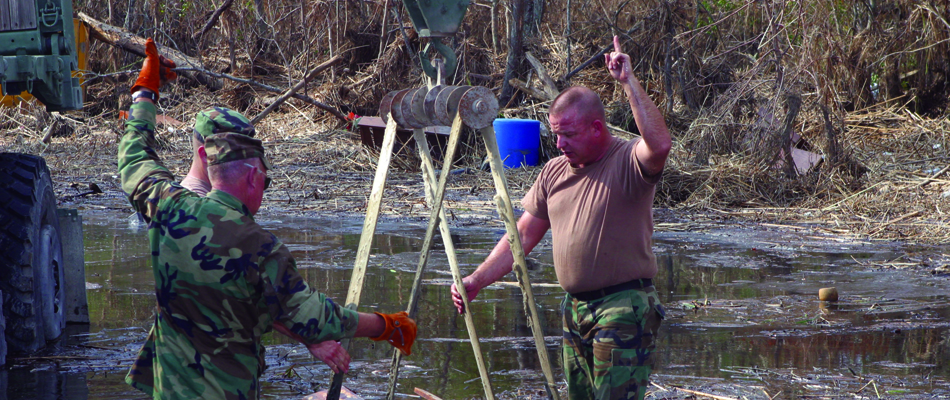
115th Engineer Group Soldiers prepare to lift vaults that were washed away from Louisiana cemeteries.

Staff Sgt. Angela Dohm prepares an injection site for a shot at a free clinic Sept. 14, 2005. Photo by Tech. Sgt. Bob Oldham

Army National Guard Soldiers from 1-204th Air Defense Artillery Battalion, Newton Miss., distribute Meals Ready to Eat and ice to people while at Pascagoula, Miss., during humanitarian relief efforts in support of Joint Task Force Katrina, Sept. 3, 2005. U.S. Air Force photo by Master Sgt. James M. Bowman
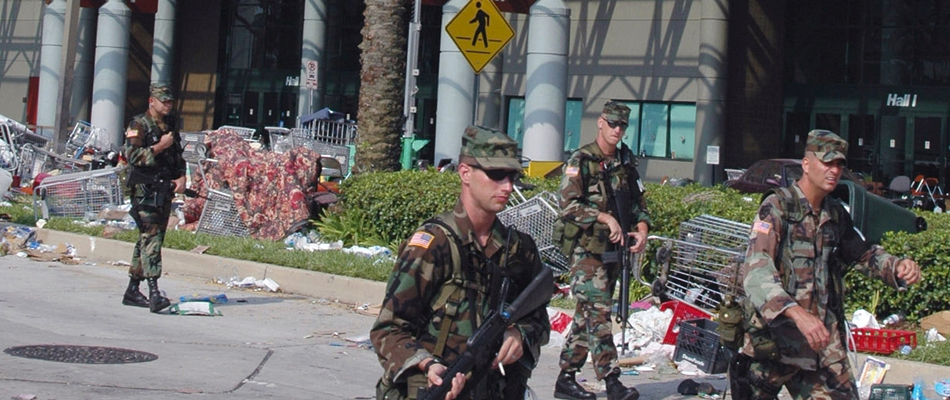
Soldiers from the Nevada Army Guard’s 72nd Military Police Company file past the Ernest N. Morial Convention Center after assisting more than 4,000 people in evacuating from the area around the Convention Center on Sept. 2, 2005. Photo by Sgt. 1st Class Erick Studenicka, Nevada National Guard

Utilizing the rescue crane in their UH-1 Huey helicopter, members of the 832nd Medical Company, Wisconsin Army National Guard, hoist a Hurricane Katrina survivor from an apartment building completely surrounded by flood waters, Sept. 5, 2005. Air National Guard photo by Tech. Sgt. Paul Gorman

Army Spc. James Meidl, heavy equipment operator, from the 890th Engineering Battalion, Columbia, Miss., operates a D-7 Dozer to help clear the roads while in Pass Christian, Miss., during humanitarian relief efforts in support of Joint Task Force Katrina, Sept. 4, 2005. U.S. Air Force photo by Master Sgt. James M. Bowman

Maj. Timothy A. Doherty of the 148th Medical Company, Georgia Army National Guard, helps a man up from a school building near downtown New Orleans after being stranded by the flood waters that ravished the city. The Army National Guard has been mobilized to take part in Joint Task Force Katrina, a humanitarian assistance operation in an effort led by the Department of Defense in conjunction with the Federal Emergency Management Agency. U.S. Navy photo by Photographer's Mate First Class (AW) Brien Aho, Fleet Combat Camera, Atlantic
The National Guard (both Army and Air)
flew approximately 7,000 sorties,
and airlifted nearly 11,000 tons
of cargo to the affected areas.

Spc. Clint Aucoia from Morgan City, Louisiana, and Pvt. 1st Class Christopher Tiffit from Spokane, Washington, both assigned to the Army National Guard, attach cargo hooks supporting large bags of sand to a CH-47 Chinook helicopter. The huge bags of sand were used to plug the levee which burst during Hurricane Katrina and caused so much devastation within the city, leaving thousands either homeless or dead. U.S. Navy photo by Photographer's Mate First Class (AW/SW) Robert McRill, Fleet Combat Camera, Atlantic
Sept. 8, 2005 At the peak of the response,
more than 51,000 Army and Air Guardsmen
were on the ground in the Gulf region.

On Sept. 1, 2005, Maryland Air National Guard and Army National Guard are transported by MDANG C-130J to Jackson, Mississippi, with supplies for Hurricane Katrina relief efforts. U.S. Air Force photo by Senior Master Sgt. Jim Foard

Second Lt. Latonya Smith goes over a morning intelligence briefing for members of North Carolina National Guard's QRF (Quick Response Force) before convoying to their next location. Photo by Tech Sgt Brian E. Christiansen, North Carolina National Guard Office of Public Affairs

Members of Task Force 320 from Camp Blanding, Florida, Florida National Guard, ready their Zodiac boats for search and rescue missions in New Orleans after Hurricane Katrina destroyed the area. Florida Air National Guard Photo by Master Sgt. Shaun Withers

The crew of a CH-47 Chinook uses a water basket to collect and drop water in the efforts to squelch two house fires in downtown New Orleans, Sept. 6, 2005. The Chinook was part of a joint military and civilian effort to assist firefighters on the ground fighting two blazing house fires apparently set by arsonists. U.S. Air Force photo by Master Sgt. Scott Reed

Maj. Gen. Harold Cross, the adjutant general of Mississippi, holds a briefing regarding Hurricane Katrina operations. Photo courtesy of the Mississippi National Guard
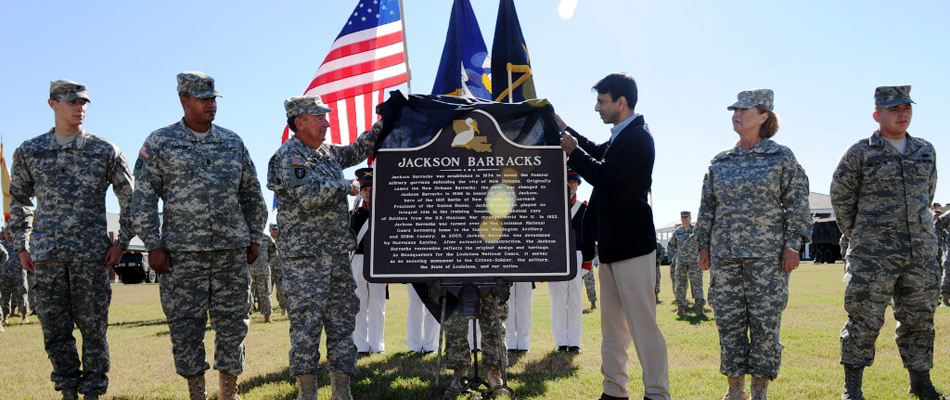
Maj. Gen. Bennett C. Landreneau, adjutant general of the Louisiana National Guard and Gov. Bobby Jindal unveil the new historic marker during the rededication ceremony of Jackson Barracks in New Orleans, Nov. 5, 2010. The ceremony marked the official return of the LANG's Headquarters to Jackson Barracks. U.S. Air Force Photo by Master Sgt. Toby M. Valadie, Louisiana National Guard Public Affairs Office
More than 17,000 people saved
from flooding or other hazards,
and 51,000 people airlifted
out of the affected areas
by the Army and Air National Guard.

Members of the Oklahoma Army National Guard and agents from the Drug Enforcement Administration ride in a 5-ton truck performing block-to-block searches, Sept. 7, 2005. The military and federal agencies are performing house-to-house searches, rescuing New Orleans residents stranded in their homes due to flood waters caused by Hurricane Katrina. U.S. Air Force photo by Master Sgt. Scott Reed

Members of the 1st Battalion, 200th Infantry Regiment, New Mexico National Guard, dressed in waders and protective gear, start cleanup duty in Plaquemines Parish, Louisiana, September 2005. Photographer unknown; courtesy of the 1-200th Infantry Regiment, New Mexico National Guard

A relieved New Orleans family, after being rescued from the rooftop of a flooded home by a New York Air National Guard helicopter, September 2005. Photographer unknown; courtesy Maj. Emily J. Desrosier, 106th Rescue Wing, New York Air National Guard Public Affairs Office
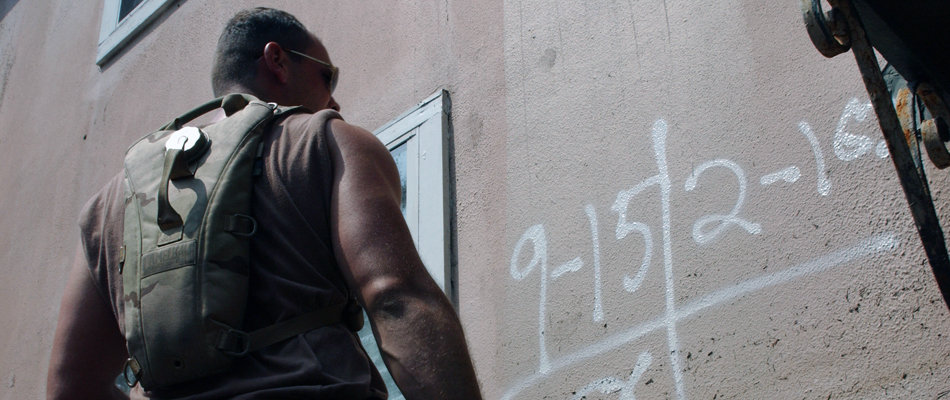
Spc. Ryan Klein of Dayton, Oregon, uses spray paint to mark an apartment building, indicating that no survivors were seen or heard during a door to door external search by boat in northern New Orleans on Sept 15th, 2005. Members of the the 2nd Battalion, 162nd Infantry and the 41st Brigade, Oregon Army National Guard, deployed to New Orleans to participate in the search and recovery efforts in the wake of Hurricane Katrina. U.S. Air Force photo by Tech. Sgt. Roger M. Dey

Jackson Barracks photographed at the height of the hurricane, August 29, 2005. Courtesy of Maj. James Worley, 159th Fighter Wing, Louisiana Air National Guard

On Sept. 1, 2005, the Maryland Air Guard support team and Maryland Army National Guard Security Forces arrive

Task Force Cyclone commander, Maj. Gen. Gregory J. Vadnais talks with Soldiers from the Alliance, Ohio-based B. Battery, 1-134th Field Artillery Battalion during a visit to their temporary headquarters at the Mississippi National Guard Armory in Poplarville, Mississippi Sept. 6.

Rooftop in New Orleans, photographed by helicopter pilots from the 106th Rescue Wing, New York Air National Guard, in September 2005. This kind of scene typified the desperation of residents often forced to the highest points in their residences to escape floodwaters released by levee breaks in the New Orleans area, who sought to gain the attention of rescue helicopters flying in the area. Photographer unknown; courtesy Maj. Emily J. Desrosier, New York Air National Guard 106th Rescue Wing Public Affairs Office
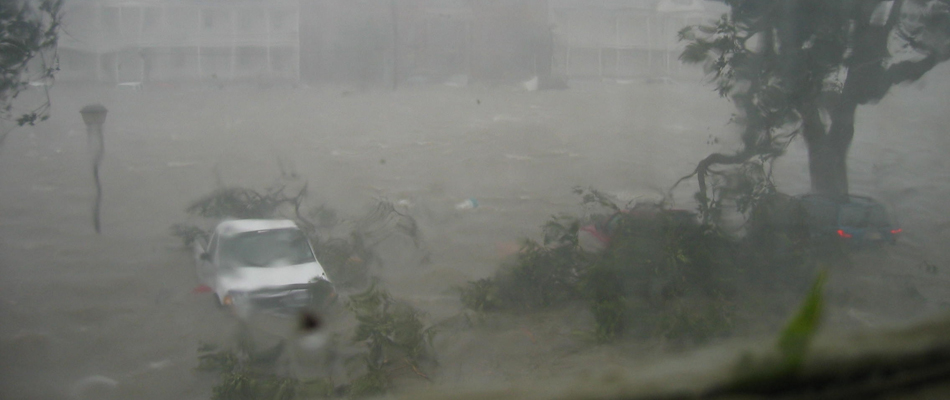
Jackson Barracks photographed at the height of the hurricane, August 29, 2005. Courtesy of Maj. James Worley, 159th Fighter Wing, Louisiana Air National Guard